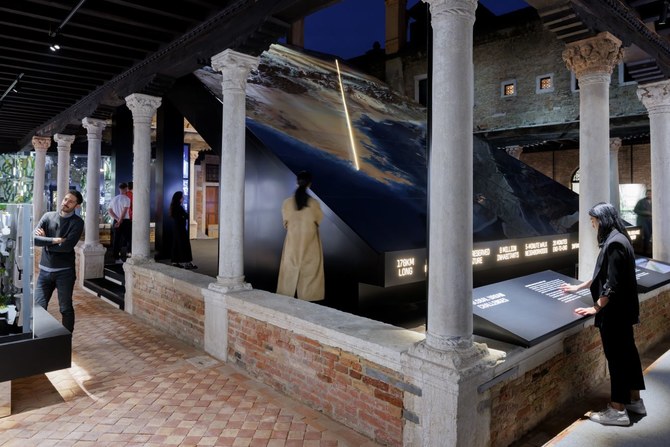VENICE: The futuristic avant-garde designs of The Line, Saudi Arabia’s trailblazing linear city, are on view for the first time outside of the Kingdom during the 18th edition of the Venice Architecture Biennale.
The Line is part of NEOM, a smart city being constructed in the Kingdom’s Tabuk region of the country — a city that, in many ways, fits perfectly with the theme of this year’s biennale, “The Laboratory of the Future,” and with its focus on architecture from historically under-represented parts of the world.

As soon as visitors step inside the building, they will come face to face with the exhibition’s focal point: a large-scale 9x13 meter relief plan of NEOM set in in the central courtyard, highlighting The Line’s futuristic design, its non-disruptive interaction with its natural environmentm and its passage through coastal, mountain and desert landscapes. (Supplied)
The designs are on show in the exhibition “Zero Gravity Urbanism: Principles for a New Livability,” which is being staged in a former church, the Abbazia di San Gregorio, one of Venice’s oldest buildings, and injects high-tech futurism into the Renaissance and Gothic architecture of its location. It also provides a glimpse of the riveting architecture of The Line, the world’s first linear city.
As soon as visitors step inside the building, they will come face to face with the exhibition’s focal point: a large-scale 9x13 meter relief plan of NEOM set in in the central courtyard, highlighting The Line’s futuristic design, its non-disruptive interaction with its natural environmentm and its passage through coastal, mountain and desert landscapes.
The exhibition uses high-tech maquettes, simulations and installations to explain Zero Gravity Urbanism, which the show’s organizers define as “a linear and three-dimensional concept that provides an innovative alternative to our current urban model.”
The design is intended to address key global challenges, not just in terms of climate change but also the growing demand for urban land, and rising social and economic inequalities. People from all classes, cultures and walks of life will reportedly be able to find a home in The Line, which also aims to provide a model for developing cities with a radical approach to conservation and standards of living.
The exhibition runs until Sept. 24. It brings together 20 of the world’s leading architects, designers and “future thinkers” and marks the launch of the Zero Gravity Urbanism concept. Sir Peter Cook, Massimiliano Fuksas, Jean Nouvel and Ben van Berkel were among the world-renowned architects who joined CEO Nadhmi Al-Nasr and other representatives from NEOM leadership at the exhibition’s opening ceremony, attended by more than 100 other architects from around the world.
“Venice is the debut of Zero Gravity Urbanism to the world,” Tarek Qaddumi, executive director of urban planning at NEOM, told Arab News. “What better place to do it in than Venice? It also reflects the idea of the laboratory of the future. We are bringing forward an idea, rather than just the design. The design becomes the manifestation of that idea for a solution to the current challenges of the world.
“We can only imagine that the rest of the world has their own take on things, but we believe that Zero Gravity Urbanism offers solutions across sectors,” he added. “The exhibition represents an important first step onto the global stage for Zero Gravity Urbanism, as the world’s wider architecture community now has the opportunity to see the depth of thinking and work that has gone into this incredible project from so many prominent thinkers and architects.”
Ultimately, the exhibition is not just about the aesthetics and technological prowess of The Line’s cutting-edge architecture, but also presents a vision of solutions for pressing urban and global problems.
Antoni Vives, NEOM’s chief urban planning officer, said in a press release: “Brought to life in Venice through the design proposals and intellectual contribution of the world’s leading architects and urban thinkers, Zero Gravity Urbanism represents a proposal of how humanity can better respond to the urban challenges we face globally.”












